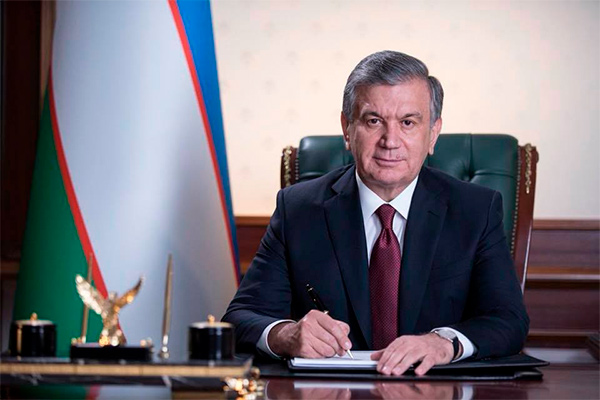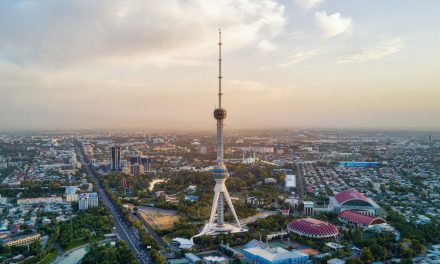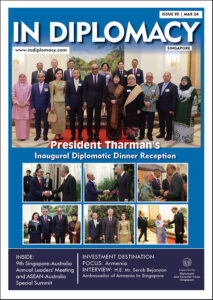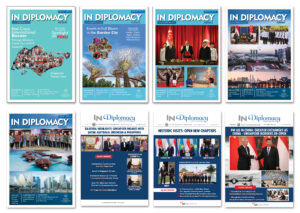
OP-Ed by Akromjon Nematov, First Deputy Director of INSTITUTE FOR STRATEGIC AND REGIONAL STUDIES (ISRS) under the President of the Republic of Uzbekistan, and Azizjon Karimov, leading Research Fellow of ISRS
WITH the election of President Shavkat Mirziyoyev, Uzbekistan has embarked on an open, proactive, a common vision of the heads of states regarding the prospects for strengthening regional cooperation.
The achieved high level of consolidation of the region and the willingness of the Central Asian countries to take responsibility for solving common regional problems is also evidenced by the adoption of a special UN resolution “Strengthening Regional and International Cooperation for Peace, Stability and Sustainable Development in the Central Asian Region in June 2018.
Thanks to all these positive trends, a number of systemic problems that previously hindered the full realization of the enormous potential of regional cooperation are now finding their long-term solution based on the principles of searching for reasonable compromises and mutual consideration of interests. Most importantly, the Central Asian states have begun to play a primary and key role in decision-making on the most pressing and urgent issues of development in the entire region.
Such strengthening of inter-state relations today contributes to the establishment of Central Asia as a stable, open and dynamically developing region, a reliable and predictable international partner as well as a capacious and attractive market.
Dynamic Trade Growth
Thus, the new political atmosphere has given a powerful impetus to the development of trade and economic, cultural and humanitarian exchanges. This can be seen in the dynamic growth of trade within the region, which reached $5.2 billion in 2019, 2.5 times more than in 2016. Contrary to the challenging effects of the pandemic, intraregional trade remained at $5 billion in 2020.
At the same time, the region’s total foreign trade in 2016-2019 increased 56 percent to $168.2 billion.
During this period, the inflow of FDI to the region increased by 40%, amounting to $ 37.6 billion. As a result, the share of investments in Central Asia from the total volume in the world increased from 1.6% to 2.5%.
At the same time, the tourist potential of the region is being revealed. The number of travelers to the countries of Central Asia in 2016-2019 increased almost 2 times – from 9.5 to 18.4 million people.
As a consequence, the overall macroeconomic indicators of the region are improving. In particular, the combined GDP of the region’s countries increased from $253 billion in 2016 to $302.8 billion in 2019. In a pandemic environment, this figure fell by just 2.5 percent to $295.1 billion by the end of 2020.
New Pragmatic Approaches
All of these factors together show that Uzbekistan’s new pragmatic approaches in its foreign policy have led to the creation of favorable conditions for the Central Asian states to jointly promote major economic projects of a transregional nature, bring their relations with neighboring regions to a new level and actively involve the region in the formation of multilateral coordination and cooperation structures.
Such plans are enshrined in the above mentioned Joint Statement of the Heads of State of Central Asia, issued at the end of the 2019 Consultative Meeting. In particular, the document notes that the Central Asian states will continue to strive to develop open economic cooperation and diversify relations with other partner countries, international and regional organizations in the hope of consolidating regional peace, stability, and expanding the prospects for economic development in the region.
These goals should be served by the political and economic concept of interconnectedness promoted by Uzbekistan, which is based on the desire to build a solid architecture of mutually beneficial cooperation between Central and South Asia.
These aspirations of official Tashkent are motivated by the interest of all states of both regions in developing closer relations, a clear understanding of the indivisibility of security, the complementary nature of economies and the interconnectedness of socio-economic development processes in Central and South Asia.
The implementation of these plans is designed to contribute to the construction of a vast space of equal opportunities, mutually beneficial cooperation and sustainable development. A logical consequence of this should be the creation of a belt of stability around Central Asia.
Sustainable Model of Inter-regional Connectivity.
Guided by these goals, the President of the Republic of Uzbekistan Shavkat Mirziyoyev put forward an initiative to hold in July of this year in Tashkent the international conference “Central and South Asia: Regional Interconnectedness. Challenges and Opportunities”, designed to consolidate the countries of the two regions in designing the conceptual foundations of a sustainable model of inter-regional connectivity.
This idea was first voiced during the speech of the head of Uzbekistan at the 75th session of the United Nations General Assembly. These issues took center stage in another important political event in 2020 – the President’s address to the Parliament, where South Asia was identified as a priority in the country’s foreign policy.
At the same time, Uzbekistan has significantly increased its political and diplomatic activity in the South Asian direction. This is reflected in the promotion of the “India-Central Asia” dialogue format, a series of virtual summits “Uzbekistan-India” (December 2020) and “Uzbekistan-Pakistan” (April 2021). (April 2021).
In this regard, the signing of the Uzbekistan-Afghanistan-Pakistan trilateral agreement to create the Trans-Afghan corridor designed to connect the countries of the two regions with a reliable transport network was a landmark event.
All these steps show that Uzbekistan has in fact already started implementing plans to build a large trans-regional interconnectedness.
The upcoming high-level conference should become a system-forming element and a kind of culmination of these efforts.
In this regard, the planned event has already aroused increased interest among a wide range of regional and international experts, who have noted the importance and relevance of the upcoming conference.
In particular, observers and analysts of such authoritative international editions as “Diplomat” (USA), “Project Syndicate” (USA), “Modern Diplomacy” (European Union), “Radio Free Europe” (EU), “Nezavisimaya Gazeta” (Russia), “Anadolu” (Turkey) and “Tribune” (Pakistan) comment on the plans of building interregional connectivity.
According to their estimations, the results of the forthcoming conference could give a start to the idea of a grandiose integration project, implying rapprochement of the two fast-growing and culturally-civilizationally close regions.
Such a prospect could create a new economic growth point for Central and South Asia, dramatically transforming the economic picture of the macro-region and improving interregional coordination to ensure stability.
Afghanistan as a key link to ensure integration of the two regions
Trans-Afghan Corridor Key for Trans-regional Connectivity
Building trans-regional connectivity, of which the Trans-Afghan Corridor is a strategic component, places Afghanistan at the core of intra-regional connectivity and recaptures its lost historic role as a key link in promoting integration between the two regions.
The realization of these goals is especially necessary against the background of the upcoming withdrawal of U.S. troops from Afghanistan, scheduled for September of this year. Such developments undoubtedly create a turning point in the modern history of Afghanistan.
On the one hand, the U.S. withdrawal, which is considered a key condition for the so-called Doha agreements, could give a strong impetus to the peace process in the neighboring country, contributing to the establishment of Afghanistan as a sovereign and prosperous state.
On the other hand, the appearance of a power vacuum threatens to intensify the internal armed struggle for power with the risk of escalating it into fratricidal war. The clashes between the Taliban and the Afghan government forces are already increasing in intensity, which may negatively affect the prospects for achieving an internal political consensus.
All the above-mentioned tectonic changes taking place in and around Afghanistan make the forthcoming conference even more topical, demonstrating the correctness of Uzbekistan’s chosen course towards inter-regional rapprochement, as the current realities in Afghanistan make cooperation between the two regions an objective and vital necessity.
Realizing this, Uzbekistan intends to start the process of adaptation of the states of the two regions to the post-American era in Afghanistan. After all, the prospect of the upcoming withdrawal of the US contingent should encourage all neighboring nations to assume a significant share of responsibility for the economic and military-political situation in Afghanistan, improvement in which is the key to securing the long-term stability of the macro-region.
Given this fact, Uzbekistan is trying to achieve a broad regional consensus on the Afghan issue by demonstrating the beneficial nature of establishing early peace in the long-suffering neighboring country for the overall prosperity of all regional states.
In this regard, foreign experts are convinced that Tashkent’s plans for interconnectedness organically complement the current Afghan policy of Uzbekistan, in which the republic is in search of a mutually acceptable formula for peace and ways to ensure long-term stability in Afghanistan.
Such an ideal recipe for peace is interregional economic integration with the involvement of Afghanistan, which will certainly have a stabilizing effect on the internal situation in the country.
A wide range of experts hold such an opinion. In particular, according to the Russian newspaper Nezavisimaya Gazeta, the Mazar-e-Sharif-Kabul-Peshawar railway project promoted by Tashkent will become an “economic springboard” for Afghanistan, since the route will run along the deposits of minerals such as copper, tin, granite, zinc and iron ore.
As a result, their development will begin, and tens of thousands of jobs will be created – alternative sources of income for the Afghan population.
Most importantly, the expansion of inter-regional trade through Afghanistan will bring economic benefits to the country in the form of transit fees. In this context, the opinion of the analysts of the American publication “Project Syndicate” is interesting, according to which the “Trans-Afghan” railroad could transport up to 20 million tons of cargo per year and the transport costs would be reduced by 30-35%.
With this in mind, observers from the Turkish newspaper Anadolu are convinced that the proposed railway connection through Afghanistan is a source of enormous economic benefits, which could stabilize the region more than any political deal.
The practical implementation of these plans is also vital against the background of the continued dependence of the Afghan economy on foreign aid, the scale of which in recent years has shown a declining trend.
In particular, the amount of annual financial support from donors, which covers about 75% of the country’s public spending, has dropped from $6.7 billion in 2011 to about $4 billion in 2020. It is expected that in the next 4 years these indicators will decrease by about 30%.
Economic Revival of Afghanistan
In these conditions, there is a growing need to accelerate the implementation of other economic projects of trans-regional scale, which can create additional favorable conditions for the economic revival of Afghanistan.
Among them one can highlight such projects as the Turkmenistan-Afghanistan-Pakistan-India gas pipeline and CASA-1000 electric power line, whose practical implementation would not only have a very positive impact on ensuring energy security in Afghanistan, but would also bring considerable financial benefits to the Afghan side from the transit of energy resources to South Asian countries.
In turn, the prospect of Afghanistan becoming an important transit and energy hub will create additional interest for all intra-Afghan forces in achieving political consensus and will serve as a solid socio-economic basis for the peace process. In short, the extensive involvement of the Afghan side in the system of inter-regional relations, created by Tashkent, could be used as a reinforcing mechanism in promoting stability.
Central Asia towards a Diversification of Transport & Transit Routes
Strengthening interregional ties meets the goals of the Central Asian states to diversify transport routes and increase the competitiveness of the region as an international transport and transit hub.
During summit meetings, the leaders of the Central Asian states have repeatedly expressed their collective intention to advocate the strengthening of coordination and deepening of regional cooperation in the joint implementation of major economic projects, especially those aimed at expanding transport and transit opportunities, ensuring stable access to seaports and world markets, and establishing modern international logistics centers.
The need to solve these problems is dictated by the persisting transport isolation of Central Asia, which prevents the deep integration of the region into global supply chains and the Central Asian states from gaining their rightful place in the emerging new model of the international trading system.
Thus, today the states of the region, having no direct access to seaports, bear substantial transport and transit costs, which reach 60 percent of the cost of imported goods. Carriers lose up to 40 percent of the time for transporting goods due to imperfect customs procedures and underdeveloped logistics.
For example, the cost of shipping a container to the Chinese city of Shanghai from any Central Asian country is more than 5 times higher than the cost of transporting it from Poland or Turkey.
Other Transport Corridors & Projects
At the same time, in recent years the Central Asian states have already succeeded in providing access to seaports of Iran, Georgia, Turkey, Azerbaijan and Russia by using the potential of various transport corridors (“Baku-Tbilisi-Kars”, “Kazakhstan-Turkmenistan-Iran”, “Uzbekistan-Turkmenistan-Iran”, “Uzbekistan-Kazakhstan-Russia”).
Among these transit routes, the North-South International Transport Corridor stands out, which currently provides access for Central Asian goods through Iranian ports to world markets. At the same time, this project is an example of successful connection of Central Asian states with India, which is the largest economy of South Asia.
In this context, the implementation of the railway project “Mazar-e-Sharif – Kabul – Peshawar” will contribute to the emergence of an additional corridor and the formation of an extensive network of railway lines designed to physically bring the countries of Central and South Asia closer together. This is the relevance of the idea promoted by Uzbekistan of trans-regional interconnectivity, the practical implementation of which would benefit all the states of the two regions.
The beneficiaries of the above plans will also be the main actors of international trade, such as China, Russia and the European Union, which are interested in providing reliable land access to the South Asian market as a viable alternative to maritime trade routes.
With this in mind, there is a high probability of internationalization of the Mazar-e-Sharif-Kabul-Peshawar railway project, i.e., expansion of the circle of parties interested in financing and further use of the transit potential of this corridor.
For this reason, it is clear that Uzbekistan’s plans go far beyond the trans-regional agenda, as the construction of the said railroad will become an important part of international transport corridors linking the European Union, China, Russia, South and Southeast Asian states through the territory of Central Asia.
As a result, the transport importance of the Central Asian states will increase significantly, which in the future will have the opportunity to ensure their active participation in the international transit of goods. This will provide them with additional sources of income, such as transit fees.
Reduction of Transport Costs
Another important achievement will be the reduction of transport costs. According to economists’ calculations, transporting a container from the city of Tashkent to the Pakistani port of Karachi will cost about $1,400 to $1,600. It is about half as cheap as transportation from Tashkent to the Iranian port – Bandar Abbas (2600-3000 dollars).
In addition, thanks to the implementation of the Trans-Afghan corridor project, the Central Asian states will be able to take advantage of the transit potential of two routes leading to the southern seas at once.
On the one hand, there are already existing corridors to the Iranian ports of Chabahar and Bandar Abbas, on the other hand – “Mazar-e-Sharif – Kabul – Peshawar” with further access to the Pakistani ports of Karachi and Gwadar. Such an arrangement will contribute to the formation of a more flexible pricing policy between Iran and Pakistan, which will significantly reduce export-import costs.
Most importantly, the diversification of trade routes will have a very favorable effect on the macroeconomic situation in Central Asia. According to World Bank experts, further removal of geographical barriers to trade with the outside world could increase the aggregate GDP of the Central Asian states by at least 15 percent.
Collective Response to Common Challenges
The format of the upcoming conference will provide a unique opportunity for senior officials, experts, and policymakers from the two regions to gather for the first time in one place to lay the foundation stone for a new transregional security architecture with the vision of building a space of equal opportunity that takes into account the interests of all parties involved.
This development of cooperation can be a model of inclusiveness, creating an enabling environment in which each country can realize its creative potential and work together to solve security problems.
This is necessary because of the inseparability of security and sustainable development – the interest of Central and South Asian states to come together in the face of common challenges and threats that have a negative impact on ensuring the continued prosperity of the two regions.
Among these challenges, experts single out problems such as drug trafficking, terrorism, the epidemiological crisis, climate change, and water scarcity, which the states of the two regions could confront by joint efforts – by identifying common problems and taking coordinated measures to overcome them.
In particular, Russian, European and Pakistani experts point to the need to use the platform of the upcoming conference to build a system of collective struggle against drug trafficking. The relevance of this is argued by the continuing reputation of Afghanistan as the main drug hub in the world.
This is confirmed by data from the UN Office on Drugs and Crime, according to which, in the past five years, 84% of global opium production comes from Afghanistan.
In these conditions, according to the Pakistani expert – executive director of the Center for Global and Strategic Studies of Pakistan, Khalid Taimur Akram, ” until there is control on both sides and improvement of the drug situation in the region, this state of affairs continues to serve as a material fuel for destructive forces – terrorism and cross-border crime.”
Climate Change Problems Examined
Foreign experts also pay special attention to the problems of climate change, which has a direct negative impact on the economies of the two regions. The year 2020 was one of the three warmest years on record.
Such extreme weather events, combined with the COVID-19 pandemic, have a double shock effect on most countries of the world, including Central and South Asia.
Moreover, Central and South Asia is an example of a water-deficient macro-region. Such situation makes them vulnerable to the global climate change process.
In the emerging environment, both regions are becoming aware of the climate crisis, which should be accompanied by the formation of a common understanding of the need for joint efforts.
Given these factors, experts call on the states of the two regions to take advantage of the international forum provided by Tashkent to identify concrete plans to jointly combat climate challenges. In particular, the adoption of coordinated steps by the states towards the active use of nature-saving technologies and increasing the energy efficiency of national economies in order to minimize the negative impact of extreme weather conditions is considered very necessary.
New Model of Trans-regional Connectivity for Inclusive Economic Growth
With the creation of a new architecture of mutually beneficial cooperation between the regions, which the upcoming conference should contribute to, the most favorable conditions will be formed for a significant increase in the level of trans-regional trade and economic exchanges.
The majority of international experts are of this opinion. According to their estimates, the implementation of the interconnectivity initiative will connect the isolated Central Asian market, rich in hydrocarbon and agro-industrial resources, with the growing consumer market of South Asia and further with the world market.
This is especially necessary given the significant unrealized potential for cooperation in the trade and economic sphere, the full utilization of which is hindered by the lack of a reliable transport network and institutional mechanisms of cooperation.
In particular, the volume of mutual trade between Central Asian and South Asian countries has not yet reached $6 billion. These figures are significantly lower compared to the South Asian region’s trade with the outside world, which exceeds $1.4 trillion.
At the same time, South Asia’s total imports have been growing steadily since 2009, reaching $791 billion in 2020. Such a situation makes the South Asian market one of the most important for Central Asian countries. In addition, with a combined population of 1.9 billion (24% of the world’s population) and a GDP of $3.5 trillion, South Asia is the fastest growing region in the world (economic growth of 7.5% per year).
In this context, a recent report by the World Bank is interesting. It notes that, despite the challenging effects of the pandemic, South Asia’s prospects for economic recovery are improving. Economic growth is expected to reach 7.2% in 2021 and 4.4% in 2022. This is a comeback from the historic low in 2020, and means the region is on a recovery trajectory. Thus, South Asia could gradually regain its status as the world’s fastest-growing region.
Given all these factors, experts note that Central Asian producers have every chance to occupy their niche in the South Asian market – to fully realize their export potential.
For example, a recent special report by ESCAP (United Nations Economic and Social Commission for Asia and the Pacific) estimates that regional export growth of Central Asian states as a result of increased inter-regional connectivity will be 187% compared to 2010, and that exports of South Asian countries will be 133% higher than in 2010.
In this regard, it is necessary to highlight a number of areas in which the development of cooperation is in the interests of all Central and South Asian states.
First, the investment sphere. The need to increase cooperation in this area is dictated by the declining trend in foreign direct investment in developing countries. According to experts at the UN Conference on Trade and Development (UNCTAD), the volume of FDI in developing countries declined by 12% in 2020 alone. But even such a slight reduction, according to experts, can jeopardize their recovery from the pandemic.
Experts argue that this assumption is based on the continuing need of Asian countries to attract large amounts of investment to maintain economic growth.
According to ADB, developing Asian countries need to invest a whopping $1.7 trillion a year between 2016 and 2030 just to meet their infrastructure demand. Meanwhile, Asian countries are currently investing about $881 billion a year in infrastructure.
In these conditions, the urgency of active investment cooperation between the states of Central and South Asia, as well as the adoption of collective measures for the progressive improvement of the investment climate of the macroregion, increases. Such joint actions could contribute to the transformation of Central and South Asia into a place of concentration of international financial flows.
Second, the agricultural sector. The agricultural sector is considered one of the most promising areas for trade and economic cooperation due to the high demand in South Asia for Central Asian food products.
For example, South Asian countries still experience a deficit of certain categories of food products and annually import food products worth approximately $30 billion (India – $23 billion, Pakistan – $5 billion, Afghanistan – $900 million, Nepal – $250 million). Specifically, Nepal currently imports 80 percent of the grain it consumes, and food import costs have increased by 62 percent in the last 5 years. Pakistan’s food import spending has also increased, rising 52.16% in the first 6 months of 2020 alone.
Third, the energy sector. Most South Asian states are net importers of hydrocarbons. The region is also periodically experiencing severe electricity shortages. In particular, the economic driver of South Asia – India – is the third largest oil importer in the world and the third largest consumer of electricity (annual consumption – 1.54 trillion kWh). Every year, the country imports energy resources worth 250 billion dollars.
Under these conditions, the implementation of large multilateral projects in the energy sector is considered to be in high demand. Thus, the progress in developing the interregional energy project “CASA-1000” will not only increase the opportunities for electricity trade between the regions, but will also be the first step towards creating a regional electricity market in Central and South Asia.
In turn, the implementation of the TAPI (Turkmenistan-Afghanistan-Pakistan-India) gas pipeline project, designed to become a symbol of peace and good neighborliness, will strengthen the role of Central Asian states in the energy security architecture of the South Asian region.
Fourth, tourism. The demand for cooperation in the tourism sector is due to the enormous untapped potential between the two regions. This can be seen in the example of Uzbekistan’s tourism cooperation with South Asian countries.
In particular, in 2019-2020 only 125 thousand people visited Uzbekistan from South Asian countries. (1.5% of the total number of tourists), and the total export of tourism services to the countries of the region amounted to 89 million dollars. (5,5%).
In addition, outbound tourism from South Asian countries is expected to grow. The UN World Tourism Organization predicts that the number of Indian tourists in the world will increase 122% to 50 million by 2022 from 23 million in 2019, and their average expenditure to $45 billion by 2022 from $23 billion. The number of tourists from Bangladesh will increase by 2.6 million over the period, and from Sri Lanka by 2 million.
Fifth, the science and education sector. Central Asian universities, especially medical schools, are becoming attractive to young people from South Asian countries. The growing number of students studying at Central Asian universities is a striking confirmation of this. In 2020, their number will reach 20,000. Such increased interest of South Asian youth to the educational services of Central Asian states can be explained by the high quality of training and relatively low cost of education.
In this regard, the states of both regions are interested in further strengthening cooperation in the field of education. This will significantly improve the system of training highly qualified personnel in both regions, which is necessary for overcoming social inequality and creating a competitive knowledge-based economy. Most importantly, strengthening cooperation in science and education can give a powerful impetus to scientific and innovative breakthroughs. After all, it is intellectual resources together with the latest technologies that are the decisive engine of economic development.
In this context, it is noteworthy that the volume of the global market of high technology today is estimated at 3.5 trillion dollars, which already exceeds the market of raw materials and energy resources. In this regard, one promising area for the development of cooperation between Central and South Asia is considered to be innovation.
Sixth, the cultural and humanitarian sphere. The implementation of any integration project is impossible without the formation of a common cultural and humanitarian space that can bring together peoples of the two regions, increase mutual trust and strengthen friendly relations.
After all, cooperation in this area contributes to mutual enrichment and interpenetration of cultures, which is a key condition for building and developing sustainable and long-term relations between the two regions in the spheres of economy, politics and security.
These goals require significant steps toward intercultural rapprochement. There are all the necessary historical prerequisites for this. The cultural ties between the vast subregion of Central and South Asia are deeply rooted in history. They date back to the period of such ancient empires as the Kushan, Bactria, and the Achaemenid state.
All these states were located on huge territories that included partially or completely modern territories of Central and South Asia. It was then – in the III-II millennia BC, the foundations of trade routes were laid, an extensive network of land routes emerged, which included access to India through Afghanistan. In turn, the ancient cities of Central Asia were the place of intersection of trade routes from China, Europe, and India.
In this context, it is clear that the head of Uzbekistan Sh. Mirziyoyev has a clear strategic vision: the “Third Renaissance” taking place in Uzbekistan should be accompanied by the revival of historical ties with neighboring regions, the restoration of ancient caravan routes, including the Great Silk Road, which has long played the role of a conductor of knowledge, innovation and prosperity. Such developments are in tune with Uzbekistan’s regional strategy. After all, historically Central Asia has reached its peak of prosperity, acting as a crossroads of world civilizations and one of the main centers of international trade.“
In general, the practical implementation of Uzbekistan’s plans for interconnectedness can create a new economic reality in two regions at once, forming the most favorable ground and all necessary conditions for the inclusive economic development of Central and South Asian states, as well as the progressive improvement of the well-being and prosperity of peoples living in these regions.
This perspective shows that our country’s plans for interconnectedness are of global significance, as improving the macroeconomic situation and strengthening stability in the two densely populated regions of the world would have a very positive impact on international security. In this regard, this initiative can be regarded as another reflection of Uzbekistan’s aspirations to make its worthy contribution to ensuring and maintaining international peace and sustainable development.

















